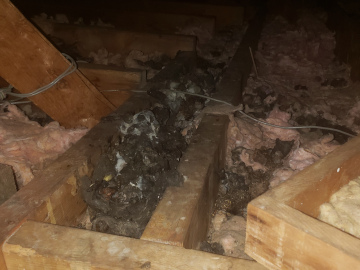Raccoons are interesting animals because of their mask-like faces and ringed tails. Even though they are a normal part of wildlife habitat, finding them in your attic can be scary. Let’s look into the reasons raccoons might decide to break into attics and talk about how to get rid of this problem effectively.
1. Safe Places to Nest: Raccoons look for safe, out of the way places to nest and raise their young, and attics are perfect for them. Attics are great places for female raccoons to give birth and care for their young because they are warm, dark, and relatively quiet.
2. Patterns that change with the seasons: Raccoons most often break into attics in late winter and early spring. This fits with their breeding cycle, when females look for safe places to give birth and care for their kits.
3. Great jumpers: Raccoons are great jumpers and can easily get up buildings like houses to get to attics. Their strong bodies and quick hands let them get in through vents, roof edges, and soffits, among other places.
4. How Close It Is to Natural homes: Raccoons often choose an attic based on how close it is to their natural homes. Raccoons may see your attic as an easy way to expand their territory if your home is close to wooded areas or easy access to food sources.
5. Attracted by Scent Trails: Raccoons have a very good sense of smell and can follow the scent trails that other raccoons have left behind. If you don’t get rid of the smell that raccoons leave behind in your attic, it can attract more of them. This can happen over and over again if you don’t take action.
6. Homes with weak structures: Raccoons may be more likely to break into older homes or homes with weak structures. Animals that are quick on their feet can easily get in through weak spots like missing or broken soffits, chimney caps, or rotting wood.
7. Curiosity and Exploration: Raccoons are naturally curious animals, and attics are a great place for them to explore. They might break in just to see what’s going on, especially if they smell food or places to nest.
8. Health Risks and Concerns: Raccoons in attics can damage your home’s structure, but they can also be harmful to your health. Raccoon poop, pee, and parasites can be harmful to people’s health, so getting rid of them and cleaning up their mess right away is very important.
9. Professional rat Removal: If a rat breaks in, you need professional help. Wildlife removal professionals do thorough checks to find entry spots and figure out how bad the infestation is. One-way doors and other humane methods of removal are used to make sure that the raccoons can leave but not come back.
10. Prevention and Exclusion: Once the raccoons are gone, it’s very important to close up any holes they could use to get in. Wildlife experts will fix weak spots, put up barriers, and give advice on how to keep break-ins from happening again.
Finally, knowing why raccoons get into attics is the first thing that needs to be done to get rid of them and keep them from coming back. Professional wildlife removal services offer humane options that put the health and safety of both people and raccoons first. People can keep their attics safe and live with raccoons in the wild by fixing any structural problems, getting rid of things that draw them, and taking other preventative steps.
